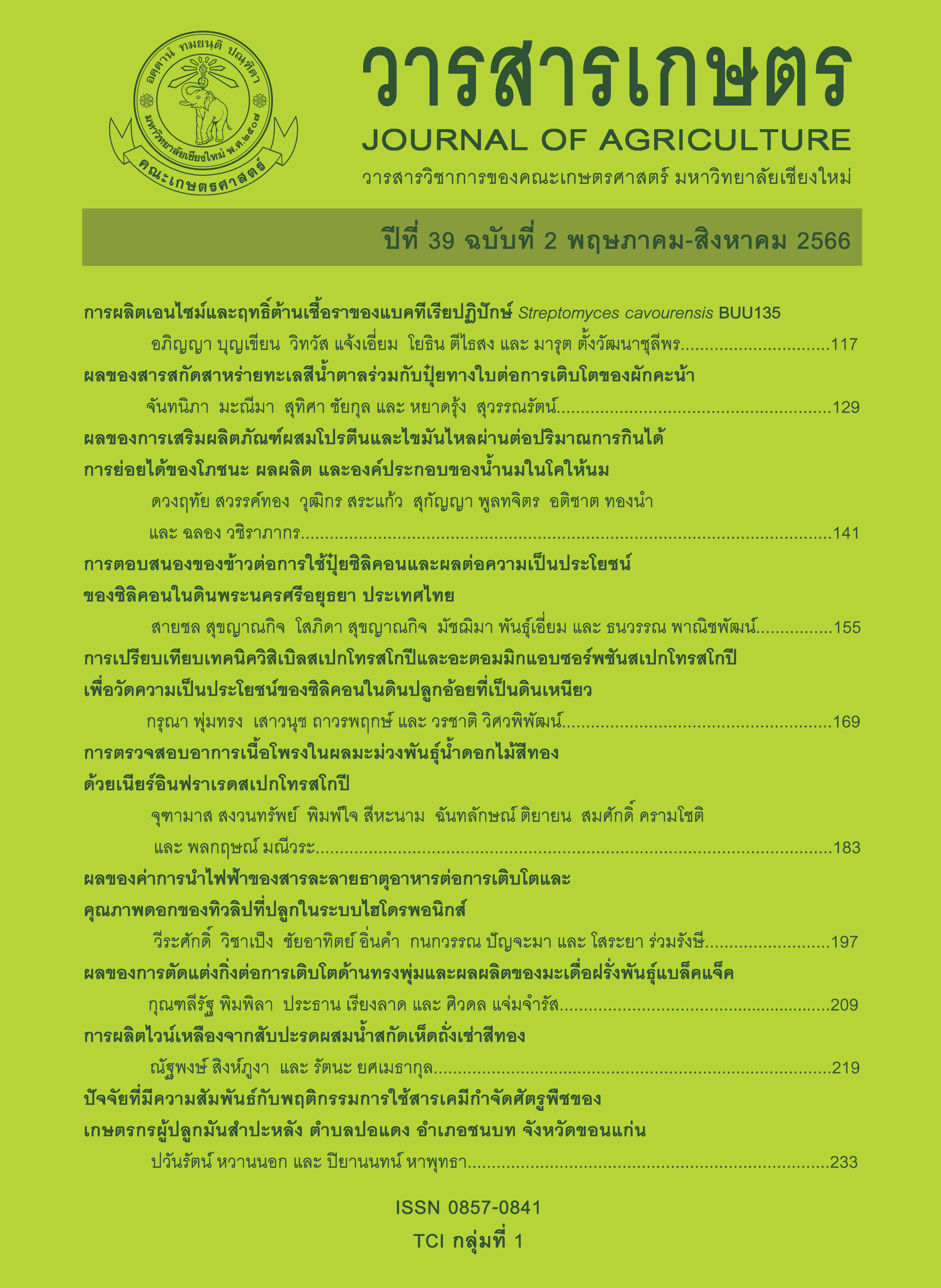ผลของสารสกัดสาหร่ายทะเลสีน้ำตาลร่วมกับปุ๋ยทางใบต่อการเติบโตของผักคะน้า
Main Article Content
บทคัดย่อ
งานวิจัยนี้มีวัตถุประสงค์เพื่อศึกษาผลของการใช้สารสกัดสาหร่ายทะเลสีน้ำตาลร่วมกับปุ๋ยทางใบเพื่อใช้เป็นสารส่งเสริมการเจริญเติบโตของผักคะน้าทำการทดลองในกระถาง โดยวางแผนการทดลองแบบสุ่มสมบูรณ์ มี 8 กรรมวิธี จำนวน 3 ซ้ำ ได้แก่ T1, น้ำเปล่า (control); T2, ปุ๋ยทางใบสูตร 15 - 15 - 15 อัตรา 1 เปอร์เซ็นต์; T3, สารสกัดสาหร่ายทะเล 1 เปอร์เซ็นต์; T4, สารสกัดสาหร่ายทะเล 2 เปอร์เซ็นต์; T5, สารสกัดสาหร่ายทะเล 3 เปอร์เซ็นต์; T6, สารสกัดสาหร่ายทะเล 1 เปอร์เซ็นต์ ร่วมกับปุ๋ยทางใบสูตร 15 - 15 - 15 อัตรา 1 เปอร์เซ็นต์; T7, สารสกัดสาหร่ายทะเล 2 เปอร์เซ็นต์ ร่วมกับปุ๋ยทางใบสูตร 15 - 15 - 15 อัตรา 1 เปอร์เซ็นต์ และ; T8, สารสกัดสาหร่ายทะเล 3 เปอร์เซ็นต์ ร่วมกับปุ๋ยทางใบสูตร 15 - 15 - 15 อัตรา 1 เปอร์เซ็นต์ บันทึกข้อมูลความสูง เส้นรอบวงลำต้น ค่าความเขียวใบ และจำนวนใบ เมื่อต้นคะน้ามีอายุ 38, 45 และ 52 วันนับจากวันย้ายปลูก บันทึกน้ำหนักสดต้น น้ำหนักแห้งต้น ปริมาณของไนโตรเจน ฟอสฟอรัสและโพแทสเซียมของต้นคะน้าในวันที่เก็บเกี่ยวเมื่ออายุ 53 วัน ผลการทดลองพบว่า การพ่นสารสกัดสาหร่ายทะเล 2 เปอร์เซ็นต์ ร่วมกับปุ๋ยทางใบสูตร 15 - 15 - 15 อัตรา 1 เปอร์เซ็นต์ แสดงทั้งแนวโน้มและแสดงการเจริญเติบโตและน้ำหนักต้นที่ดีกว่ากรรมวิธีอื่น ๆ (P < 0.05) ผลการศึกษาชี้ให้เห็นว่าการใช้สารสกัดสาหร่ายทะเลสีน้ำตาลสามารถนำมาใช้เป็นสารส่งเสริมการเจริญเติบโตของคะน้าได้ โดยอัตราการใช้สารสกัดสาหร่ายทะเลร่วมกับปุ๋ยทางใบที่เหมาะสม คือ การใช้สารสกัดสาหร่ายทะเล 2 เปอร์เซ็นต์ ร่วมกับปุ๋ยทางใบสูตร 15 - 15 - 15 อัตรา 1 เปอร์เซ็นต์
Article Details

อนุญาตภายใต้เงื่อนไข Creative Commons Attribution-NonCommercial-NoDerivatives 4.0 International License.
เอกสารอ้างอิง
Attanandana, T. and C. Chancharoensuk. 1999. Exercises and Laboratory Manual for Soil and Plant Analysis. Department of Soil Science, Faculty of Agriculture Kasetsart University, Bangkok. (in Thai)
Battacharyya, D., M.Z. Babgohari, P. Rathor and B. Prithiviraj. 2015. Seaweed extracts as biostimulants in horticulture. Scientia Horticulturae 196: 39-48.
Blunden, G., T. Jenkins and Y.-W. Liu. 1996. Enhanced leaf chlorophyll levels in plants treated with seaweed extract. Journal of Applied Phycology 8: 535-543.
Bremner, J.M. and C.S. Mulvaney. 1982. Nitrogen-total. pp. 595-624. In: A.L. Page, R.H. Miller and D.R. Keeney (eds.). Methods of Soil Analysis: Part 2 Chemical and Microbiological Properties. American Society of Agronomy, Soil Science Society of America, Madison, Wisconsin.
Department of Agricultural Extension. 2008. Cruciferous vegetables (kale, cauliflower). Instruction manual. Bureau of Agricultural Commodities Promotion and Management, Bangkok. 39 p. (in Thai)
Department of Agricultural Extension. 2016. Information on exporting fresh exotic vegetables. (Online). Available: http://www. doa.go.th/ard/File-Upload/export/5.4.2/Vegetable59.pdf (September 10, 2020). (in Thai)
Halpern, M., A. Bar-Tal, M. Ofek, D. Minz, T. Muller and U. Yermiyahu. 2015. The use of biostimulants for enhancing nutrient uptake. pp. 141-174. In: D.L. Sparks (ed.). Advances in Agronomy. Academic Press. Delaware.
Jackson, K.W. and T.M. Mahmood. 1994. Atomic absorption, atomic emission, and flame emission spectrometry. Analytical Chemistry 66(12): 252-279.
Jarassamrit, N. 1998. Hormones and Plant Growth Regulators. Rua Khiao, Bangkok. 124 p. (in Thai)
Jayasinghe, P.S., V. Pahalawattaarachchi and K.K.D.S. Ranaweera. 2016. Effect of seaweed liquid fertilizer on plant growth of Capsicum annum. Discovery 52(244): 723-734.
Khan, W., U. Rayirath, S. Subramanian, M. Jithesh, P. Rayorath, M. Hodges, A. Critchley, J. Craigie, J. Norrie and B. Prithiviraj. 2009. Seaweed extracts as biostimulants of plant growth and development. Journal of Plant Growth Regulation 28(4): 386-399.
Naphrom, D. and K. Sringarm. 2009. Techniques for Analyzing Plant Hormone Content. Faculty of Agriculture, Chiang Mai University, Chiang Mai. 29 p. (in Thai)
Niyamanon, S., S. Niyamanon and M. Saknimit. 2002. Utilization of marine algae as fertilizer to increase cauliflower production in Amphur Pa-Phyom, Phatthalung province. Thaksin University, Phatthalung. 55 p. (in Thai)
Osotsapar, Y. 2014. Bio accelerators as plant growth promoting. Thai Journal of Soils and Fertilizers 36(1-4): 27-54. (in Thai)
Sasikala, M., E. Indumathi, S. Radhika and R. Sasireka. 2016. Effect of seaweed extract (Sargassum tenerrimum) on seed germination and growth of tomato plant (Solanum lycopersicum). International Journal of ChemTech Research 9(9): 285-293.
Spinelli, F., G. Fiori, M. Noferini, M. Sprocatti and G. Costa. 2010. A novel type of seaweed extract as a natural alternative to the use of iron chelates in strawberry production. Scientia Horticulturae 125: 263-269.
Sukho, P., S. Chaikul, N. Chanasit and T. Pankasemsuk. 2017. Effects of GA3, NAA and brassin-like substance (BS) on size and weight of rambutan fruit (Nephelium lappaceum L. cv. Rongrian). Journal of Agriculture 33(2): 175-184. (in Thai)
Sutharsan, S., S. Nishanthi and S. Srikrishnah. 2014. Effect of foliar application of seaweed (Sargassum crassifolium) liquid extract on the performance of Lycopersicon esculentum mill. in sandy regosal of Batticaloa district Sri Lanka. American-Eurasian Journal of Agricultural & Environmental Sciences 14(12): 1386-1396.
Thongra-ar, P., S. Kaewsuralikhit, K. Chatchaisiri, K. Suvittawat, P. Phenchang, N. Thaweenut and P. Saradhuldhat. 2017. The combination of blue-green algae extract and foliar fertilizer accelerates growth in micro- propagated banana ‘Namwa Pakchong 50’. Songklanakarin Journal of Plant Science 4(4): 16-21. (in Thai)
Thongra-ar, P., S. Kaewsuralikhit, P. Meunchang, K. Prongjunthuek, P. Kanchanakesorn and S. Sangtavee. 2021. Effect of cyanobacterial extract on growth and yield of lettuce. Final Report. Agricultural Production Science Research and Development Division, Department of Agriculture, Bangkok. 16 p. (in Thai)
Tongumpai, P. 1994. Plant Hormones and The Synthetics: Potential Uses in Thailand. 4 th ed. Kasetsart University, Bangkok. 196 p. (in Thai)


